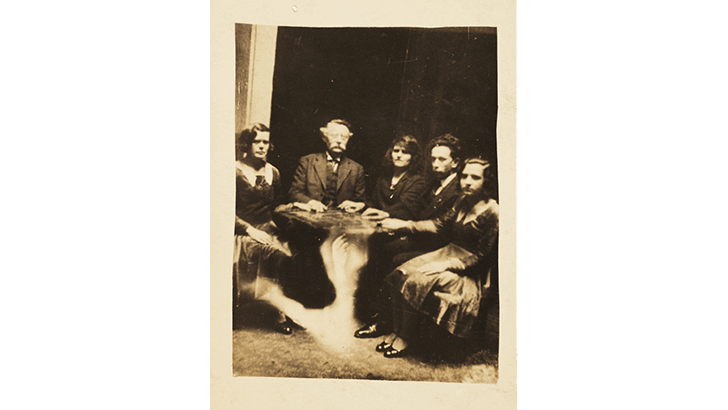Resources
Astin, Alexander W., Helen S. Astin, and Jennifer A. Lindholm. 2011. Cultivating the Spirit: How College Can Enhance Students’ Inner Lives. San Francisco: Jossey-Bass.
Armstrong, Thomas. 1984. “Transpersonal Experience in Childhood.” Journal of Transpersonal Psychology 16, no. 2: 207–230.
Aronowitz, Stanley. 1988. Science as Power: Discourse and ideology in Modern Society. Minneapolis: University of Minnesota Press.
Bader, Christopher David, Frederick Carson Mencken, and Joe Baker. 2010. Paranormal America: Ghost Encounters, UFO Sightings, Bigfoot Hunts, and Other Curiosities in Religion and Culture. New York: New York University Press.
Barnett, Ronald. 1997. Higher Education: A Critical Business. Buckingham: SRHE/Open University Press.
Belenky, Mary Field, Blythe Mcvicker Clinchy, Nancy Rule Goldberger, and Jill Mattuck Tarule. 1986. Women's Ways of Knowing. New York: Basic Books.
Bourguignon, Erika. Possession. 1991. Prospect Heights: Waveland Press.
Braswell, Gregory S., Karl S. Rosengren, and Howard Berenbaum. 2012. “Gravity, God and Ghosts? Parents’ Beliefs in Science, Religion and the Paranormal and the Encouragement of Beliefs in their Children.” International Journal of Behavioral Development 36, no. 2: 99–106.
Castro, Madeleine A. 2009. Talking of Transcendence: A discursive exploration into how people make sense of their extraordinary experiences. Unpublished thesis: University of York.
Castro, Madeleine, Roger Burrows, and Robin Wooffitt. 2014. “The Paranormal is (Still) Normal: The Sociological Implications of Paranormal Experiences in Great Britain.” Sociological Research Online 19, no. 3: 1–16.
Caterine, Darryl V. 2011. Haunted Ground: Journeys Through a Paranormal America. Santa Barbara: Praeger.
Clifford, James, ed. 1986. Writing Culture: the Poetics and Politics of Ethnography. Berkeley: University of California Press.
Cottrell, Stella. 2005. Critical Thinking Skills: Developing Effective Analysis and Argument. Basingstoke: Palgrave Macmillan.
Dawkins, Richard. February 8, 1998. “Aliens Are Not Among Us.” Sunday Mirror.
Dewey, J. 1909. How We Think. Boston: D.C. Heath and Co. Available online: https://archive.org/details/howwethink000838mbp
Emmons, Charles F., and Jeff Sobal. 1981. “Paranormal Beliefs: Functional Alternatives to Mainstream Religion?” Review of Religious Research 22, no. 4: 301–312.
Fisher, Robert. 2003. Teaching Thinking. London: Continuum.
Frankfurter, David. 2008. Evil Incarnate: Rumors of Demonic Conspiracy and Satanic Abuse in History. Princeton, N.J.: Princeton University Press.
Freud, Sigmund. 1961. “A Seventeenth-Century Demonological Neurosis.” In The Standard Edition of the Complete Psychological Works of Sigmund Freud XIX (72–105). London: The Hogarth Press.
Greeley, Andrew. 1991. “The Paranormal is Normal: A Sociologist Looks at Parapsychology.” Journal of the American Society for Psychical Research, 85 (October): 367–374.
Greeley, Andrew M. 1975. The Sociology of the Paranormal. Thousand Oaks, CA: Sage Publications.
Hay, David. 1998. “Why Should We Care About Children’s Spirituality?” Pastoral Care 16, no. 1: 11–16.
Holt, James D. 2014. Religious Education in the Secondary School: An Introduction to Teaching, Learning and the World Religions. London: Routledge.
Hunter, Jack. 2016. “Ordinary Theology in the Classroom: Experience and Belief in Secondary Religious Education.” RE Today 33, no. 2: 58–61.
Hunter, Jack. 2015. Strange Dimensions. Lulu.com.
Hyde, Lewis. 2010. Trickster Makes This World: Mischief, Myth, and Art. New York: Farrar, Straus and Giroux.
International Center for the Assessment of Higher Order Thinking. “The Critical Thinking Community.” http://www.criticalthinking.org/
Kripal, Jeffrey J. 2010. Authors of the Impossible: The Paranormal and the Sacred. Chicago: University of Chicago Press.
Kripal, Jeffrey. 2010. Authors of the Impossible: The Paranormal and the Sacred. Chicago: University of Chicago Press.
Laycock, Joseph P. 2015. “Religious Studies and the Paranormal.” EdgeScience 21: 12–14.
Mannheim, Karl. 1954. Ideology and Utopia: An Introduction to the Sociology of Knowledge. New York: Harcourt Brace.
Martin, Michael. 1994. “Pseudoscience, the Paranormal and Science Education.” Science and Education 3, no. 4: 357–371.
Mason, Mark, ed. 2008. Critical Thinking and Learning. Oxford: Blackwell Publishing.
Mayer, Elizabeth Lloyd. 2008. Extraordinary Knowing: Science, Skepticism, and the Inexplicable Powers of the Human Mind. New York: Bantam.
McClenon, James. 1994. Wondrous Events: Foundations of Religious Belief. Philadelphia: University of Pennsylvania Press.
Meyers, Chet. 1986. Teaching Students to Think Critically: A Guide for Faculty in All Disciplines. San Francisco, JosseyBass.
Moon, Jennifer. 2008. Critical Thinking: An Exploration of Theory and Practice. London: Routledge.
Noll, Richard. 1993. “Exorcism and Possession: The Clash of Worldviews and the Hubris of Psychiatry,” Dissociation 6, no. 4: 250–253.
OFSTED. 2015. School Inspection Handbook. Manchester: OFSTED.
Onions, Patrick. 2009. "Thinking Critically: An Introduction.” Working paper, available online at http://www.patrickonions.org/docs/academic/2009%20Thinking%20critically.pdf
Sagan, Carl. 2013. The Demon-Haunted World: Science as a Candle in the Dark. New York: Random House.
Tamminen, Kalevi. 1994. “Religious Experience in Childhood and Adolescence: A Viewpoint of Religious Development Between the Ages of 7 and 20.” The International Journal for the Psychology of Religion 4, no. 2: 61–85.
Taussig, Michael. 2006. “Viscerality, Faith, and Skepticism: Another Theory of Magic.” In Walter Benjamin’s Grave (121–156). Chicago: University of Chicago Press.
Vygotsky, L. S. 1978. Mind in Society: The Development of Higher Psychological Processes. Cambridge, MA: Harvard University Press.

